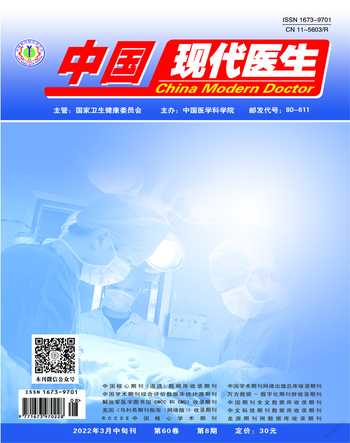鸡蛋壳负载的纳米氧化锌对大肠杆菌的体外抑菌作用
陈雅瑜 许婉卿 陈芳川 戴秋婷 丁志雄 黄聪明 郑丹萍 赖顺霞


[摘要] 目的 牙科设备水管经常被微生物膜污染,微生物膜中含大量有害微生物,大肠杆菌是其主要的微生物之一。蛋壳作为日常生活中的废弃物,将其废物利用负载纳米氧化锌。为寻找牙科设备水管的新型消毒剂,探讨研究蛋壳负载纳米氧化锌对大肠杆菌的影响。方法 鸡蛋壳溶解硝酸钾溶液中,经过过滤煅烧溶解冷却,得到鸡蛋壳负载的纳米氧化锌,电镜观察蛋壳及蛋壳负载的纳米氧化锌形态。选用大肠杆菌ATCC 25922作为实验菌株。测定蛋壳负载纳米氧化锌对大肠杆菌的最低抑菌浓度(MIC)和最低杀菌浓度(MBC)。结果 纳米氧化锌对大肠杆菌的最低抑菌浓度640 μg/ml,最低杀菌浓度为5120 μg/ml。结论 蛋壳负载的纳米氧化锌能抑制大肠杆菌的生长,可以作为牙科设备水管的新型消毒剂。
[关键词] 鸡蛋壳;纳米氧化锌;大肠杆菌;抑菌
[中图分类号] R378.2 [文献标识码] A [文章编号] 1673-9701(2022)08-0016-04
In vitro antibacterial effect of eggshell-loaded nano-zinc oxide on Escherichia coli
CHEN Yayu XU Wanqing CHEN Fangchuan DAI Qiuting DING Zhixiong HUANG Congming ZHENG Danping LAI Shunxia
Department of Stomatology, the Second Affiliated Hospital of Fujian Medical University, Quanzhou 362000, China
[Abstract] Objective The water pipe of dental equipment is often polluted by microbial membrane, which contains a large number of harmful microorganisms, and Escherichia coli is one of the main microorganisms. Eggshell as a waste in daily life, its waste is used to load nano-zinc oxide. The effect of eggshell-loaded nano-zinc oxide on Escherichia coli was studied in order to find a new disinfectant for the dental equipment water pipe. Methods The eggshell was dissolved in potassium nitrate solution, and eggshell-loaded nano-zinc oxide was obtained after filtration, calcination, dissolved and cooling. The morphology of eggshell and eggshell-loaded nano-zinc oxide was observed under the electron microscope. Escherichia coli ATCC 25922 was selected as the experimental strain. The minimum inhibitory concentration (MIC) and minimum bactericidal concentration(MBC) of eggshell-loaded nano-zinc oxide on Escherichia coli were determined. Results The minimum inhibitory concentration and bactericidal concentration of nano-zinc oxide on Escherichia coli were 640 μg/ml and 5120 μg/ml respectively. Conclusion Eggshell-loaded nano-zinc oxide inhibits the growth of Escherichia coli and can be used as a new disinfectant for dental equipment water pipes.
[Key words] Eggshell; Nano-zinc oxide; Escherichia coli; Antibacterial
在口腔治療中,高速手机避免过热,需要大量水降温;这些水通过狭窄的塑料管、阀门流向牙椅,即牙科设备水管。研究表明,牙科设备水管经常被生物膜污染,而大肠杆菌(Escherichia coli,E.coli)是生物膜主要检出的微生物之一[1-4]。2009—2017年,共603篇文章报道,美国由大肠杆菌引起的疾病有7869例[5]。大肠杆菌是革兰阴性短杆菌,是人和动物肠道中的正常栖居菌,常引起腹泻和败血症。
现代社会抗生素滥用,使抗生素耐药性迅速增长[6]。Nsima等[7]研究显示,40%~100%的大肠杆菌分离株对氨苄西林、青霉素、四环素和头孢噻肟耐药。虽然化学消毒被认为是最有效控制微生物污染的方法,但其对水路管道和患者的有害影响不容忽视[8]。因此需寻找一种新型材料既能抑菌又对人体无害。研究报道,蛋壳负载的锶具有理想的热稳定性和生物活性[9]。氧化锌被广泛用作食品添加剂、食品补充剂和药物成分[10],金属纳米材料已被证明是抗生素的安全有效替代材料,且不会引起耐药[11]。纳米氧化锌以其催化效率、化学稳定性和强大的吸附能力而闻名[12]。本篇研究观察蛋壳负载的纳米氧化锌对大肠杆菌的体外抑制作用,现报道如下。
1 材料与方法
1.1材料
鸡蛋壳由泉州师范学院化工学院杨大鹏教授提供。硝酸锌(国药集团化学试剂有限公司)。大肠杆菌(ATCC 25922)由福建医科大学中心实验室提供。营养琼脂和肉汤(上海博威生物技术有限公司)。
1.2方法
1.2.1 蛋壳负载的纳米氧化锌的合成 ①用自来水冲洗鸡蛋壳,将所有鸡蛋壳内膜和所有附着物都去除。②去离子水将洗涤过的鸡蛋壳冲洗两次,并在室温下干燥24 h。③用研磨机将干燥的鸡蛋壳研磨成粉,并通过200目筛子过筛,保存于干燥器中以备进一步研究。④取2 g鸡蛋壳粉浸泡到100 ml的硝酸锌溶液中,在磁力搅拌下搅拌均匀1 h,过滤得到滤液,再于500℃的马弗炉煅烧3 h,自然冷却至室温,得到蛋壳负载的氧化锌纳米材料。通过场发射扫描电子显微镜(FESEM,蔡司,德国)检查样品的形态结构。见图1。
1.2.2 大肠杆菌及菌悬液制备 大肠杆菌在LB营养琼脂中培养,随后在37℃下孵育24 h。接种环取固体培养基上得单菌落,用无菌生理盐水将细菌配制成密度为0.5麦士比浊的菌悬液备用。
1.2.3 蛋壳负载纳米氧化锌对大肠杆菌的体外抑制作用 ①最小抑菌浓度的测定。取对数生长期细菌配制成0.5麦士比浊的菌悬液,LB肉汤1∶1000稀释后,实验组每孔加入100 μl稀释后的菌液;倍比稀释法配置不同浓度的纳米氧化锌,使其最终的药物浓度为5120、2560、1280、640、320、160、80、40 μg/ml。实验组:不同浓度的纳米氧化锌+菌液,阳性对照组:含菌液的LB培养基,阴性对照组:LB培养基,密封后置培养箱培养24 h。在空白对照组澄清透亮的情况下,以肉眼观察各个试管中细菌生长情况,菌液澄清时的最低浓度为纳米氧化锌对大肠杆菌的最小抑菌浓度(MIC)。②大肠杆菌最小杀菌浓度的测定[13]。观察24 h的大肠杆菌最小抑菌浓度,吸取大肠杆菌MIC、高于MIC 2个浓度梯度、阳性对照组及阴性对照组的培养物1 μl接种于LB琼脂培养基中,于培养箱中培养24 h观察有无菌落生长。以无菌落生长的最低药物浓度为纳米氧化锌对大肠杆菌最小杀菌浓度(MBC)。
2 结果
2.1 扫描电镜分析
扫描电镜观察到纳米氧化锌的形态。与具有光滑结构的鸡蛋壳相比,包裹在鸡蛋壳表面氧化锌的粒径明显小于200 nm。见图2。
注 a:1 μm电镜下鸡蛋壳表面光滑,放大倍数:10 000倍;b:200 nm电镜观察下,粒径明显<100nm的纳米氧化锌负载在鸡蛋壳表面,放大倍数:50 000倍
2.2 MIC
蛋壳负载纳米氧化锌对大肠杆菌的MIC为640 μg/ml。
2.3 MBC
蛋壳负载纳米氧化锌对大肠杆菌的MBC为5120 μg/ml。见封三图1。
3 讨论
蛋壳是日常生活中产生的一种普通的肥料,成本低,原料来源广,且可通过蛋壳利用减少环境污染。蛋壳是日常生活中最常被废弃的垃圾,但蛋壳材料已在不同领域中展现出其巨大的使用价值。蛋壳由于其多孔结构,且在高温下的强稳定性以及生物学特性常被用于骨组织工程[14-17]。蛋壳膜和芦荟凝胶组成的纳米纤维支架用于皮肤组织工程的再生[18]。Ota等[19]研究证实,煅烧后的蛋壳主要粉末为氧化钙(CaO),蛋壳衍生的CaO粉末可在3 min内灭活法式囊病病毒(IBDV)、沙门菌和大肠杆菌,原因是CaO与水混合时,水溶液变成氢氧化钙,而其pH值超过12。纳米颗粒的抗菌剂具有很多重要的应用,如纺织工业、表面消毒、伤口敷料、水处理和食品保鲜。使用无机氧化物纳米颗粒作为抗微生物的优势在于其对微生物病原体的耐药菌株有更高的效力,同时毒性和耐热性较低[20]。氧化锌由于其理化特性和生物相容性而具有杀菌作用[21]。微米级和纳米级的氧化锌均有抗菌作用,而纳米级氧化锌对细菌有更高的抗菌活性,对人类和动物是安全的[22]。纳米氧化锌负载在雞蛋壳多孔表面,既能废物利用,又能保持强稳定性和生物相容性。
生物膜的形成已经是牙科设备水管中的重要问题。牙科设备水管中生物膜的形成和微生物的生长导致用于喷雾、冷却和超声等使用过程的水中微生物数量过多[23]。如果水中含病原体,如大肠杆菌等,则年龄大且免疫力低的患者就很容易造成院内感染;大肠杆菌是院内感染常见的细菌之一,也是牙科设备水管的常驻菌之一。本研究发现,蛋壳负载的纳米氧化锌对大肠杆菌的MIC为640 μg/ml,MBC为5120 μg/ml。众多研究也表明纳米氧化锌粉末对大肠杆菌有明显的抑制作用[22,24-27]。传统观点认为,纳米氧化锌对大肠杆菌的抑制作用可能与活性氧的释放量有关[27]。但是现在越来越多的观点认为,纳米氧化锌对大肠杆菌的毒性,是由于纳米氧化锌释放的Zn离子;并且也证实,纳米氧化锌对大肠杆菌的毒性与大肠杆菌内Zn离子积累量是一致的。
综上所述,蛋壳负载的纳米氧化锌对牙科设备水管的大肠杆菌有一定程度的抑制作用,也就是可以通过蛋壳负载的纳米氧化锌对牙科设备水管进行消毒,同时可以废物利用以保护环境。
[参考文献]
[1] Alkhulaifi MM,Alotaibi DH,Alajlan H,et al. Assessment of nosocomial bacterial contamination in dental unit waterlines:Impact of flushing[J].The Saudi Dental Journal,2020,32(2):68-73.
[2] Lal S,Singhrao SK,Achilles-Day UE,et al. Risk asses- sment for the spread of serratia marcescens within dental-unit waterline systems using vermamoeba vermiformis[J].Current Microbiology,2015,71(4):434-442.
[3] Szymańska J,Sitkowska J,Dutkiewicz J. Microbial conta- mination of dental unit waterlines[J].Annals of Agricultural and Environmental Medicine:AAEM,2008,15(2):173-179.
[4] Wirthlin MR,Marshall GW Jr,Rowland RW. Formation and decontamination of biofilms in dental unit waterlines[J]. Journal of Periodontology,2003,74(11):1595-1609.
[5] Hughes AC,Patfield S,Rasooly R,et al. Validation of a cell-based assay for detection of active shiga toxins produced by Escherichia coli in water[J].International Journal of Environmental Research and Public Health,2020,17(21):7901.
[6] Peters L,Olson L,Khu DTK,et al. Multiple antibiotic re- sistance as a risk factor for mortality and prolonged hospital stay:A cohort study among neonatal intensive care patients with hospital-acquired infections caused by gram-negative bacteria in Vietnam[J].PLOS ONE,2019, 14(5):e0215 666.
[7] Nsima B,Adegoke AA,Ofon UA,et al. Resistotyping and extended-spectrum beta-lactamase genes among Esche- richia coli from wastewater treatment plants and recipient surface water for reuse in South Afria[J].New Microbes New Infect,2020,38:100 803.
[8] Demajo JK,Cassar V,Farrugia C,et al. Effectiveness of disinfectants on antimicrobial and physical properties of dental impression materials[J].The International Journal of Prosthodontics,2016,29(1):63-67.
[9] Geng Z,Cheng Y,Ma L,et al. Nanosized strontium subs- tituted hydroxyapatite prepared from egg shell for enhanced biological properties[J].Journal of Biomaterials Applications,2018,32(7):896-905.
[10] Lansdown AB,Mirastschijski U,Stubbs N,et al. Zinc in wo- und healing:Theoretical,experimental,and clinical aspects[J].Wound Repair and Regeneration,2007,15(1):2-16.
[11] Alekish M,Ismail ZB,Albiss B,et al. In vitro antibacte rial effects of zinc oxide nanoparticles on multiple drug-resistant strains of Staphylococcus aureus and Escherichia coli:An alternative approach for antibacterial therapy of mastitis in sheep[J].Veterinary World,2018,11(10):1428-1432.
[12] Banoee M,Seif S,Nazari ZE,et al. ZnO nanoparticles enh- anced antibacterial activity of ciprofloxacin against Staphylococcus aureus and Escherichia coli[J].Journal of Biomedical Materials Research Part B:Applied Biomater-ials,2010,93(2):557-561.
[13] Chang L,Feng Y,Wang B,et al. Dual functional oyster s-hell-derived Ag/ZnO/CaCO3 nanocomposites with enh-anced catalyticand antibacterial activities for water purification[J].RSC Advance,2019,9:41 336-41 344.
[14] Sayed M,El-Maghraby HF,Bondioli F,et al. 3D carbox- ymethyl cellulose/hydroxyapatite(CMC/HA)scaffold com-posites based on recycled eggshell[J].Journal of Applied Pharmaceutical Science,2018,8(3):23-30.
[15] Shih-ChingWu,Hsueh-ChuanHsu,Shih-KuangHsu,et al. Synthesis of hydroxyapatite from eggshell powders through ball milling and heat treatment[J].Journal of Asian Ceramic Societies,2018,4(1):604-610.
[16] Sampath Kumar TS,Madhumathi K,Rajkamal B,et al. Enh- anced protein delivery by multi-ion containing eggshell derived apatitic-alginate composite nanocarriers[J].Coll-oids Surf B Biointerfaces,2014,123(1):542-548.
[17] Siva Rama Krishna D,Siddharthan A,Seshadri SK,et al. A novel route for synthesis of nanocrystalline hydroxy-apatite from eggshell waste[J].Journal of Materials Science:Materials in Medicine,2007,18(9):1735-1743.
[18] Mohammadzadeh L,Rahbarghazi R,Salehi R,et al. A novel egg-shell membrane based hybrid nanofibrous scaffold for cutaneous tissue engineering[J].Journal of Biological Eng-ineering,2019,13:79-85.
[19] Ota M,Toyofuku C,Thammakarn C,et al. Calcinated egg- shell as a candidate of biosecurity enhancement material[J].Veterinary Week,2016,78(5):831-836.
[20] Zhang L,Jiang Y,Ding Y,et al. Mechanistic investiga- tion into antibacterial behaviour of suspensions of ZnO nanoparticles against E. coli[J].Journal of Nanoparticle Research,2010,12(5):1625-1636.
[21] Mirzaei H,Darroudi M. Zinc oxide nanoparticles:Biolo- gical synthesis and biomedical applications[J].Ceramics International,2017,43(1):907-914.
[22] Luo Z,Wu Q,Xue J,et al. Selectively enhanced antibac-terial effects and ultraviolet activation of antibiotics with ZnO nanorods against Escherichia coli[J].Journal of Biom-edical Nanotechnology,2013,9(1):69-76.
[23] Dahlen G. Biofilms in dental unit water lines[J].Monogr Oral Sci,2021,29:12-18.
[24] Song K,Zhang W,Sun C,et al. Dynamic cytotoxicity of ZnO nanoparticles and bulk particles to Escherichia coli:A view from unfixed ZnO particle:Zn2+ ratio[J].Aquat Tox-icol,2020,220:105 407.
[25] Zhang R,Carlsson F,Edman M,et al. Escherichia coli bac- teria develop adaptive resistance to antibacterial ZnO nanoparticles[J].Advanced Biosystems,2018,2(5):e180 019.
[26] Li M,Zhu L,Lin D. Toxicity of ZnO nanoparticles to Esch- erichia coli:Mechanism and the influence of medium components[J].Environmental Science&Technology,2011, 45(5):1977-1983.
[27] Banoee M,Seif S,Nazari ZE,et al. ZnO nanoparticles enhanced antibacterial activity of ciprofloxacin against Staphylococcus aureus and Escherichia coli[J].Journal of Biomedical Materials Research Part B:Applied Bioma- terials, 2010,93(2):557-561.
(收稿日期:2021-07-12)

